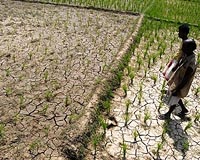| . |  |
. |
Galkayo, Somalia (AFP) Oct 4, 2009 Living in twig and cloth shelters after fleeing raging violence in Mogadishu, a severe drought has worsened the misery of thousands of Somalis settled outside the central town of Galkayo. The prolonged drought affecting millions across war-ravaged Somalia is forcing more people into Margaga camp, which was initially set up to cater for those driven out by the country's relentless clashes. "The food security situation in the drought-affected Mudug region has got worse in the past six months and we are getting an increase of displaced families almost every day," said Mohamed Hashi, a local UN officer in Galkayo, a town 700 kilometres (430 miles) north east of Mogadishu. The makeshift "tents" in Margaga camp, which hosts an some 1,160 families, consist of pieces of cloth and sacking suspended over thorn bushes. Falis Farah Omar, a divorced 24-year-old mother of two, shares one such tent with 14 members of her extended family. "We never take more than one meal a day and sometimes we stay without eating the whole day," she said, running her fingers through her younger daughter's matted brittle hair. She explained that the nearest place to get water is six kilometres away. They manage for three days on the one 20-litre container she is able to carry back. Asha Jama, 56, a multi-coloured scarf round her head, was abandoned by her husband two years ago when the last of the family's 50 camels died because of the drought. "Since then I have lived in this camp with my only surviving child," Jama said. The UN says that 3.6 million people, more than one-third of Somalia's population, are in need of humanitarian assistance. That figure has risen by 12 percent since the start of the year. The population of the camps is swollen temporarily by residents of Mogadishu fleeing fighting in the capital and who stop over on their way to Yemen. Mogadishu is the scene of almost daily gunbattles between Islamist rebels and government soldiers and the African peacekeepers supporting them. "We receive thousands fleeing Mogadishu violence every week. Most of them stop over here for some days and leave to catch the illegal smuggling boats. Some of them die out in the ocean," Ahmed Abdi Yusuf, an elder and chairman of a camp near Margaga told AFP. The UN refugee agency said this week that since the beginning of the year a total of 994 boats and 50,400 clandestine migrants have crossed the Gulf of Aden between Somalia and Yemen. Almost half of those making the crossing are Somalis. The persistent violence and the current drought have plunged the Horn of Africa country into its worst humanitarian crisis since civil war erupted two decades ago.
Share This Article With Planet Earth
Related Links Climate Science News - Modeling, Mitigation Adaptation
 Indian suffers worst drought in 37 years
Indian suffers worst drought in 37 yearsNew Delhi (AFP) Sept 30, 2009 India has suffered its worst drought since 1972, the official weather office said on Wednesday, with rains 23 percent below average at the end of the country's four-month monsoon season. "India's 2009 monsoon rainfall has been the worst since 1972," a spokesperson for the Meteorological Department, P.K. Bandhopadhyay, told AFP. In 1972, monsoon rainfall was 24 percent below average, he ... read more |
|
| The content herein, unless otherwise known to be public domain, are Copyright 1995-2009 - SpaceDaily. AFP and UPI Wire Stories are copyright Agence France-Presse and United Press International. ESA Portal Reports are copyright European Space Agency. All NASA sourced material is public domain. Additional copyrights may apply in whole or part to other bona fide parties. Advertising does not imply endorsement,agreement or approval of any opinions, statements or information provided by SpaceDaily on any Web page published or hosted by SpaceDaily. Privacy Statement |